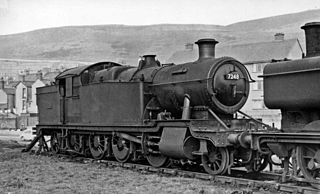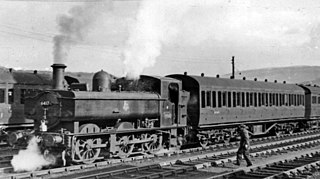
The Great Western Railway 3700 Class, or City Class, locomotives were a series of twenty 4-4-0 steam locomotives, designed for hauling express passenger trains.

The Great Western Railway 3200 Class was a design of 4-4-0 steam locomotive for passenger train work. The nickname for this class, almost universally used at the time these engines were in service was Dukedog since the locomotives were composed of former Duke Class boilers on Bulldog Class frames. As such they were one of the last standard gauge steam locomotive classes to retain outside frames.

The Great Western Railway (GWR) 4200 Class is a class of 2-8-0T steam locomotives.

The GWR 5101 Class or 'Large Prairie' is a class of 2-6-2T steam locomotives of the Great Western Railway.

The Great Western Railway (GWR) 2884 Class is a class of 2-8-0 steam locomotive. They were Collett's development of Churchward's earlier 2800 Class and are sometimes regarded as belonging to that class.

The GWR 1400 Class is a class of steam locomotive designed by the Great Western Railway for branch line passenger work. It was originally classified as the 4800 Class when introduced in 1932, and renumbered in 1946.

The Great Western Railway (GWR) 7200 Class is a class of 2-8-2T steam locomotive. They were the only 2-8-2Ts built and used by a British railway, and the largest tank engines to run on the Great Western Railway.

The Great Western Railway (GWR) 4300 Class is a class of 2-6-0 (mogul) steam locomotives, designed by G.J. Churchward for mixed traffic duties. 342 were built from 1911–1932.

The GWR 5600 Class is a class of 0-6-2T steam locomotive built between 1924 and 1928. They were designed by Charles Collett for the Great Western Railway (GWR), and were introduced into traffic in 1924. After the 1923 grouping, Swindon inherited a large and variable collection of locomotives from historic Welsh railway companies, which did not fit into their standardisation programme. GWR boiler inspectors arrived en masse and either condemned the original locomotives or had them rebuilt. The systematic destruction of many examples of locomotives, most still in serviceable condition, followed, but various were worked alongside 5600 Class.

The Great Western Railway (GWR) 5400 Class was a class of 0-6-0 pannier tank steam locomotive. They were similar in appearance to many other GWR tank engines but smaller than the ubiquitous GWR 5700 Class.

The Great Western Railway (GWR) 6400 Class is a class of 0-6-0 pannier tank steam locomotive introduced by Charles Collett in 1932. All 40 examples were 'auto-fitted' – equipped with the remote-control equipment needed for working autotrains.

The Great Western Railway (GWR) 4575 Class is a class of 2-6-2T British steam locomotives.

The Great Western Railway (GWR) 4500 Class or Small Prairie is a class of 2-6-2T steam locomotives.

The Great Western Railway (GWR) 2301 Class or Dean Goods Class is a class of British 0-6-0 steam locomotives.

The GWR 6100 Class is a class of 2-6-2T side tank steam locomotives.

The Great Western Railway (GWR) 3150 Class was a class of 2-6-2T side tank steam locomotive.
The Great Western Railway (GWR) 3600 Class was a class of 2-4-2T side tank steam locomotive, designed by William Dean and built at Swindon in three lots in 1900-1903:
The GWR 56 Class were 2-4-0 tender locomotives designed for the Great Western Railway by Joseph Armstrong and built at Swindon Works between 1871 and 1872.
The GWR 1854 Class was a class of 0-6-0T steam locomotives designed by William Dean and constructed at the Swindon Works of the Great Western Railway. The class used similar inside frames and chassis dimensions to the 1813 Class of 1882-4. In this they differed from the intervening 1661 Class, which had reverted to the double frames of the Armstrong era. Thus the 1854 Class belongs to the "mainstream" of GWR 0-6-0T classes that leads towards the larger GWR pannier tanks of the 20th century.
The 3201 or Stella Class was a class of standard gauge 2-4-0 steam locomotive, designed by William Dean and built at Swindon Works for the Great Western Railway in 1884 and 1885.

















